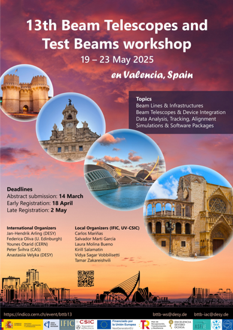Speaker
Description
The Compressed Baryonic Matter (CBM) experiment at the Facility for Antiproton and Ion Research (FAIR) in Darmstadt, Germany, is designed to explore the phase diagram of strongly interacting matter under extreme conditions such as temperature and baryon density. With high interaction rates of up to approximately ten million collisions per second with heavy-ion beams, CBM requires sophisticated detector infrastructure and a special triggerless (free-streaming) real-time data acquisition system to manage the high data flow. In this environment, a major challenge is determining the centrality (the geometric overlap of the colliding nuclei) and the reaction plane (the orientation of the collision) on an event-by-event basis. These parameters can be determined by measuring forward spectator fragments—the nucleons and fragments that do not take part in the main interaction and thus continue near the beam trajectory. Accurate measurements of these fragments are therefore crucial for comprehensive collision characterization, motivating the development of the dedicated Forward Spectator Detector (FSD).
Currently in its development and prototype testing phase at the Czech Technical University in Prague, the FSD is positioned at very small angles close to the beam line. When a spectator fragment passes through a scintillator tile, light is generated and detected by the attached fast photomultiplier tubes (PMTs). To optimize performance across different regions, the FSD employs modules in various sizes, ensuring adequate granularity. The signals are processed using the Time Over Threshold (TOT) method, and the DIRICH system handles data readout, providing accurate and efficient measurement of signal parameters. Several FSD prototype modules have been produced and tested in the mCBM setup at the GSI facility.
This presentation will discuss the challenges in designing the FSD, share recent prototype testing results, and outline the integration of the FSD into the broader CBM experimental framework. By combining modular detectors with differential granularity and advanced readout techniques, the FSD promises to enhance event reconstruction and make significant contributions to the study of dense baryonic matter.
